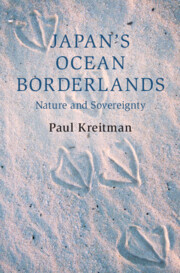Book contents
- Japan’s Ocean Borderlands
- Cambridge Oceanic Histories
- Japan’s Ocean Borderlands
- Copyright page
- Contents
- Maps
- Figures
- Acknowledgements
- Naming Conventions
- Maps
- Introduction
- 1 Bonins of Contention
- 2 The Race to Marcus Island
- 3 Bird and Sovereignty Conservation in the Northwest Hawaiian Islands, 1898–1911
- 4 Sand Dunes and Soldiers
- 5 Disaster
- 6 Resurrecting the Torishima Albatross
- 7 The Nature of the Senkaku Islands
- Epilogue
- Appendix Japanese Islands Abandoned, 1868–2013
- Select Bibliography
- Index
Introduction
Published online by Cambridge University Press: 06 July 2023
- Japan’s Ocean Borderlands
- Cambridge Oceanic Histories
- Japan’s Ocean Borderlands
- Copyright page
- Contents
- Maps
- Figures
- Acknowledgements
- Naming Conventions
- Maps
- Introduction
- 1 Bonins of Contention
- 2 The Race to Marcus Island
- 3 Bird and Sovereignty Conservation in the Northwest Hawaiian Islands, 1898–1911
- 4 Sand Dunes and Soldiers
- 5 Disaster
- 6 Resurrecting the Torishima Albatross
- 7 The Nature of the Senkaku Islands
- Epilogue
- Appendix Japanese Islands Abandoned, 1868–2013
- Select Bibliography
- Index
Summary
Japan is ringed by a number of remote oceanic islands whose economic, strategic and symbolic significance is entirely disproportionate to their tiny size. Yet today they are uninhabited, populated primarily by birds. Historically, these islands and the oceans that surround them have formed a borderland between Japan, Hawai‘i, the United States, Britain and China. First targetted for their supplies of plumage and guano, they later became launchpads for empire and landing strips for bombers. Many have now been transformed into nature reserves.
What chain of events led people to set foot on such remote spots in the first place? How did they go about claiming the islands and the birds that nested on them? What kind of human settlements once existed there, and what happened after they were abandoned? What does the history of bird islands say about Japanese imperial and post-imperial power, and about the web of political, economic and ecological connections between insular and oceanic space? And what does all this say about the relationship between sovereignty, territory and environment in the modern world?
Keywords
- Type
- Chapter
- Information
- Japan's Ocean BorderlandsNature and Sovereignty, pp. 1 - 20Publisher: Cambridge University PressPrint publication year: 2023



